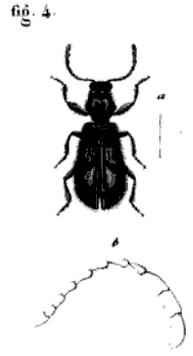
Amphizoa is a genus of aquatic beetles in the suborder Adephaga, placed in its own monogeneric family, Amphizoidae. There are five known species of Amphizoa, three in western North America and two in eastern palearctic. They are sometimes referred to by the common name troutstream beetles.

Dermestidae are a family of Coleoptera that are commonly referred to as skin beetles. Other common names include larder beetle, hide or leather beetles, carpet beetles, and khapra beetles. There are approximately 500 to 700 species worldwide. They can range in size from 1 to 12 mm. Key characteristics for adults are round oval shaped bodies covered in scales or setae. The (usually) clubbed antennae fit into deep grooves. The hind femora also fit into recesses of the coxa. Larvae are scarabaeiform and also have setae.

Hydrochus is a genus of water scavenger beetles in the monogeneric family Hydrochidae, sometimes placed in the Hydrophilidae as a subfamily Hydrochinae. The family Hydrochidae includes about 180 species, all of which are placed in the genus Hydrochus. Hydrochus has also been used for a fly genus in the family Dolichopodidae. This junior homonym is a junior subjective synonym of the genus Rhaphium.

Exosoma lusitanicum or daffodil leaf beetle is a species of skeletonizing leaf beetles belonging to the family Chrysomelidae, subfamily Galerucinae.
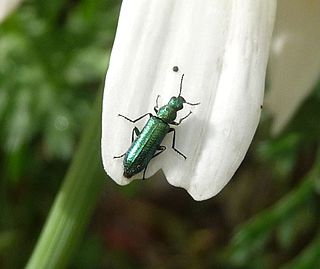
Psilothrix viridicoerulea is a species of soft-winged flower beetles belonging to the family Melyridae, subfamily Dasytinae.

Phanaeus demon is a species of beetles belonging to the family Scarabaeidae. This species is often incorrectly named as "damon" in collections and in the literature.
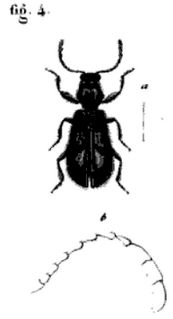
Muisca is a genus of checkered beetles of the subfamily of Clerinae or Enopliinae. It is only known from two species, the type species, Muisca bitaeniata and Muisca cylindricollis. The genus was first described by entomologist Maximilian Spinola in 1844.

Huitaca or Xubchasgagua was a rebelling goddess in the religion of the Muisca. The Muisca and their confederation were one of the four advanced civilizations of the Americas who inhabited the Altiplano Cundiboyacense in the Andes. Huitaca has been described by the chroniclers Juan de Castellanos in his Elegías de varones ilustres de Indias, Lucas Fernández de Piedrahita and Pedro Simón.
Neocorynura muiscae is a species of sweat bee of the genus Neocorynura in the subfamily of Halictinae of the family of Halictidae. It was first described by Alan Smith-Pardo and Victor Hugo González Betancourt in 2006.
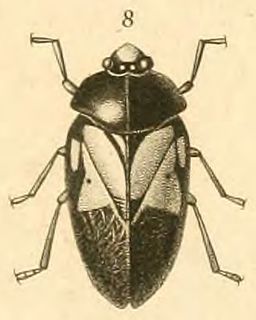
Choconta circulata is a species of froghopper in the genus Choconta, of the family of Cercopidae. The species has been named formerly Sphenorhina circulata (Lallemand), Tomaspis circulata (Fennah), and originally Cercopis circulatus. The species has been described first by French entomologist Félix Édouard Guérin-Méneville in 1844.

The Ocetá Páramo is a páramo at altitudes between 2,950 metres (9,680 ft) and 3,950 metres (12,960 ft) in the Eastern Ranges of the Colombian Andes. It covers parts of the municipalities Monguí, Mongua and Tópaga, belonging to the Sugamuxi Province, Boyacá. The Ocetá Páramo is known for its collection of frailejones and other flora, as well as Andean fauna. Hiking tours from Monguí or Mongua to the páramo take a full day.

Colilodion schulzi is a species of beetles belonging to the family Staphylinidae. This small, robust, reddish-brown rove beetle is known from a single specimen, a 2.37 millimetres (0.093 in) long female. It is in the genus Colilodion. It resembles the species C. concinnus and C. inopinatus with its enlarged antennomeres III, but it is easily distinguished by the greater maximum width and less variable width of these appendages, and by other morphological characteristics. Although its ecology is unknown, the presence of trichomes and the knowledge of related species, such as Staphylinidae suggests that this insect is myrmecophilous. The holotype was collected in 2009 in Palawan (Philippines) while sifting plant debris in a coniferous forest. The species was described in 2016 by the coleopterists Zi-Wei Yin from Shanghai Normal University and Giulio Cuccodoro from the Natural History Museum of Geneva, where the type specimen is part of the collection. The taxon's specific denomination is dedicated to the German myrmecologist Andreas Schulz, collector of the specimen.
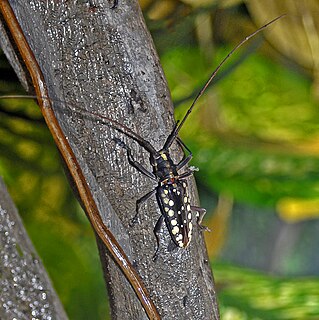
Taeniotes farinosus is a species of beetle in the family Cerambycidae. It was described by Carl Linnaeus in 1758, originally under the genus Cerambyx.
Euryomma muisca is a species of fly in the genus Euryomma. It was first described by Grisales et al. in 2012.
Muisca cylindricollis is a species of checkered beetles of the genus Muisca in the subfamily of Clerinae or Enopliinae. It was first described by zoologist Adriano Lúcio Peracchi in 1962 as Cregya cylindricollis. The same author reclassified the species as Paracregya cylindricollis in 1964. Paracregya cylindricollis was reclassified as Muisca cylindricollis by Ekis in 1975. The genus is been named after the Muisca from the Altiplano Cundiboyacense in central Colombia.

Oberea pupillata is a species of beetle in the family Cerambycidae. It was described by Leonard Gyllenhaal in 1817, originally under the genus Saperda.
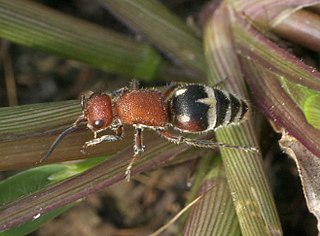
Timulla is a genus of velvet ants in the family Mutillidae. There are at least 20 described species in Timulla.

Agalmatium flavescens is a species of planthopper belonging to the family Issidae, subfamily Issinae.

Clanoptilus barnevillei is a species of beetles belonging to the family Melyridae, the soft-winged flower beetles.
